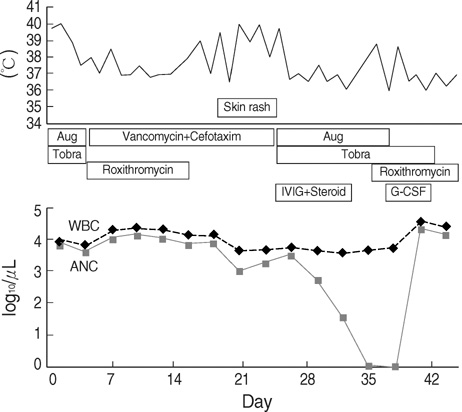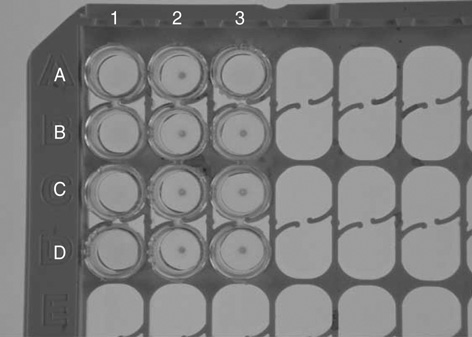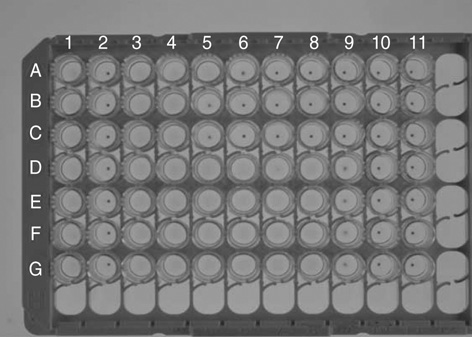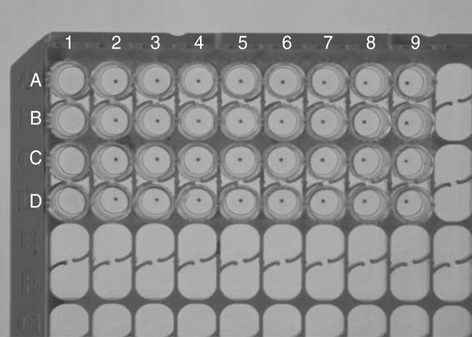J Korean Med Sci.
2009 Oct;24(5):975-978. 10.3346/jkms.2009.24.5.975.
Antibiotic-induced Severe Neutropenia with Multidrug-Dependent Antineutrophil Antibodies Developed in A Child with Streptococcus pneumoniae Infection
- Affiliations
-
- 1Department of Pediatrics, Hanyang University College of Medicine, Seoul, Korea. cord@hanyang.ac.kr
- 2Department of Laboratory Medicine, Inje University Sanggye Paik Hospital, Seoul, Korea.
- KMID: 1782027
- DOI: http://doi.org/10.3346/jkms.2009.24.5.975
Abstract
- Drug-induced neutropenia (DIN), particularly that in which antibiotic-dependent antineutrophil antibodies have been detected, is a rare disorder. We report the case of a child with pneumococcal pneumonia, who experienced severe neutropenia during various antibiotic treatments. We detected 4 kinds (cefotaxim, augmentin, vancomycin, and tobramycin) of antibiotic-dependent antineutrophil antibodies by using the mixed passive hemagglutination assay (MPHA) technique with this child.
MeSH Terms
Figure
Reference
-
1. Andres E, Kurtz JE, Maloisel F. Nonchemotherapy drug-induced agranulocytosis: experience of the Strasbourg teaching hospital (1985-2000) and review of the literature. Clin Lab Haematol. 2002. 24:99–106.2. van der Klauw MM, Goudsmit R, Halie MR, van't Veer MB, Herings RM, Wilson JH, Stricker BH. A population-based case-cohort study of drug-associated agranulocytosis. Arch Intern Med. 1999. 159:369–374.
Article3. Young NS, Alter BP, editors. Aplastic Anemia, Acquired and Inherited. 1994. Philadelphia, PA: W.B. Saunders Co.;229–267.4. Araki N, Nose Y, Kohsaki M, Mito H, Ito K. Anti-granulocyte antibody screening with extracted granulocyte antigens by a micro-mixed passive hemagglutination method. Vox Sang. 1999. 77:44–51.
Article5. Han TH, Chey MJ, Han KS. Granulocyte antibodies in Korean neonates with neutropenia. J Korean Med Sci. 2006. 21:627–632.
Article6. Han TH, Chey MJ, Han KS. A case of neonatal alloimmune neutropenia associated with anti-human neutrophil antigen-1a (HNA-1a) antibody. J Korean Med Sci. 2006. 21:351–354.
Article7. Kaufman DW, Kelly JP, Levy M, Shapiro S, editors. The Drug Etiology of Agranulocytosis and Aplastic Anaemia. 1991. New York: Oxford University Press;148–158.8. Salama A, Schütz B, Kiefel V, Breithaupt H, Mueller-Eckhardt C. Immune-mediated agranulocytosis related to drugs and their metabolites: mode of sensitization and heterogeneity of antibodies. Br J Haematol. 1989. 72:127–132.
Article9. Claas FH. Immune mechanisms leading to drug-induced blood dyscrasias. Eur J Haematol Suppl. 1996. 60:64–68.
Article10. Gerson WT, Fine DG, Spielberg SP, Sensenbrenner LL. Anticonvulsant-induced aplastic anemia: increased susceptibility to toxic drug metabolites in vitro. Blood. 1983. 61:889–893.
Article11. Weinshilboum RM. Pharmacogenetics of methyl conjugation. Prog Clin Biol Res. 1983. 135:167–181.12. Young NS. Drug-related blood dyscrasias. Introduction. Eur J Haematol Suppl. 1996. 60:6–8.13. Nyfeler B, Pichler WJ. The lymphocyte transformation test for the diagnosis of drug allergy: sensitivity and specificity. Clin Exp Allergy. 1997. 27:175–181.
Article14. Kurtz JE, Andrès E, Maloisel F, Kurtz-Illig V, Heitz D, Sibilia J, Imler M, Dufour P. Drug-induced agranulocytosis in older people. A case series of 25 patients. Age Ageing. 1999. 28:325–326.
Article
- Full Text Links
- Actions
-
Cited
- CITED
-
- Close
- Share
- Similar articles
-
- Antibiotic-Resistant Streptococcus pneumoniae
- Multidrug-Resistant Streptococcus pneumoniae Sepsis and Meningitis after Craniofacial Surgery: Case Report
- Clinical Implications of Drug-Resistant Streptococcus pneumoniae as a Cause of Community Acquired Pneumonia
- Treatment Outcome of Penicillin-resistant S. Pneumoniae Infection
- Multidrug-Resistant Gram-Positive Bacterial Infections





